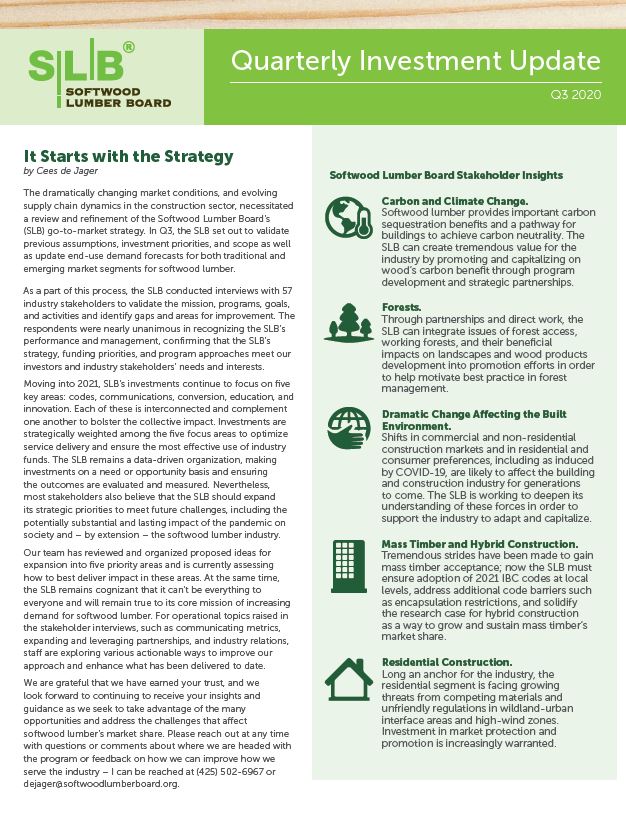HIGHLIGHTS
PROGRAM UPDATES
Think Wood Profiles Show What Is Possible When Building With Wood WoodWorks Expands Content to Reach Developers and General Contractors Think Wood Launches Biophilic Design Lead Nurturing Email Series FEMA Seismic Provisions Include CLT Shear Wall Requirements Past Investments in Research Pay Off in the Form of New Hotels at Military Bases Former AWC Manager Receives ICC’s Highest HonorINDUSTRY NEWS
Timber Advocate and Former SLB Board Member, Chuck Roady, to Retire After 45 Years CalTech Announces Plans for Research Lab Made of Mass Timber Trend Toward Suburbs, Exburbs Continues Trends in Modular Modular and Biophilic Trends Converge in Innovative Design in Amsterdam Quantifying Mass Timber’s Net Carbon Effect Key to Increasing Market 10-Story Hybrid Tower Proposed in Portland Construction Materials Pyramid Offers Fast Environmental Impact Comparison New Infographic, Data Stress Build-for-Rent as Promising Market Segment University of Oregon Team Working to Increase Wood Use in Medical Facilities 105-Story Mass Timber Skyscraper Could Zero Out Carbon FootprintINSIGHTS ON THE COMPETITION
New Study Asserts Wood as Key to Reducing Building Sector’s Carbon FootprintINDUSTRY RESOUCES
Virginia Tech's Monthly Housing ReportProgram Updates
Think Wood Profiles Show What Is Possible When Building With Wood
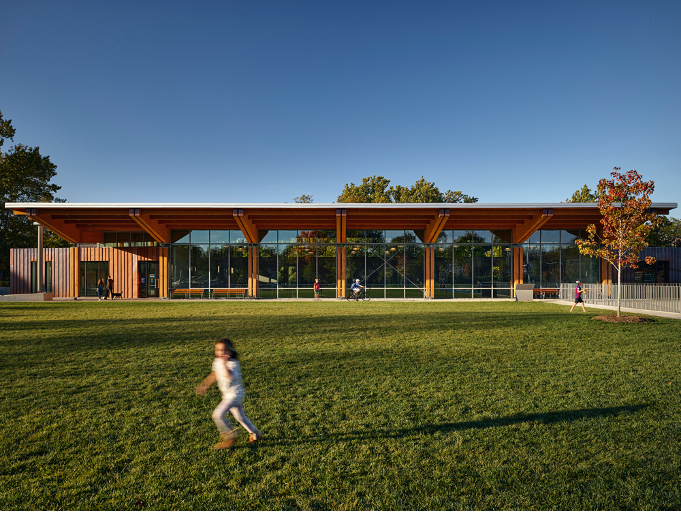
Members of Think Wood’s database consistently request project profiles of wood buildings as a vital resource in removing barriers to wood construction. Think Wood recently created a profile of the 50,000-square-foot Lubber Run Community Center in Arlington, Virginia, which uses wood as the central element in both structural and appearance applications, including heavy timber glulam columns, beams and double purlins, tongue-and-groove wood decking, and biophilic feature elements like wood plank siding. Wood’s carbon-sequestration properties are expected to help the building achieve a net-zero energy rating.
“We like wood for a number of reasons. We used it to contrast with the industrial concrete to bring in a warm aesthetic that the community was asking for, but it also had a positive [construction] schedule impact. When you use structural steel and concrete, it requires more material to be both structurally sound and have a clean finish. With mass timber, we can put up the structure, and wood itself is the finish.” – Edwin Liang, project manager at MCN Build.
The Lubber Run Community Center project profile and an accompanying Q&A with the lead architect are available on Think Wood’s project gallery and will be promoted on social media, via email, and on the What’s New page on Think Wood’s website. By profiling successful wood projects, the companies that undertake them, and the visionary professionals at the helm, Think Wood is showing architects and developers across the industry how to build with wood.
WoodWorks Expands Content to Reach Developers and General Contractors

WoodWorks’ recent two-day Wood Design Symposium delivered more than 1,000 education hours to nearly 200 design and building professionals. Notably, the symposium also purposefully included new content geared toward developers and general contractors to help build a solid business case for using wood. One of the symposium’s biggest draws was a panel discussion on spec offices, featuring two developers who shared real numbers behind their deals. This session has prompted a flurry of emails from people wanting to share the information with their teams and colleagues. Also popular were virtual mass timber building tours, which included Q&As with project team members; despite being optional sessions at the end of each day, these were accessed by 85% of symposium participants.
While architects and engineers remain its core audience, WoodWorks will increasingly integrate content targeting developers and general contractors in 2021 to overcome their unique barriers to wood use.
Q+A during the virtual tour of The Soto featuring John Beauchamp, Hixon Properties, Todd Wascher, AIA, LEED AP BD+C, Lake|Flato Architects, Bungane Mehlomakulu, PE, Integral Group Engineering.
Think Wood Launches Biophilic Design Lead Nurturing Email Series
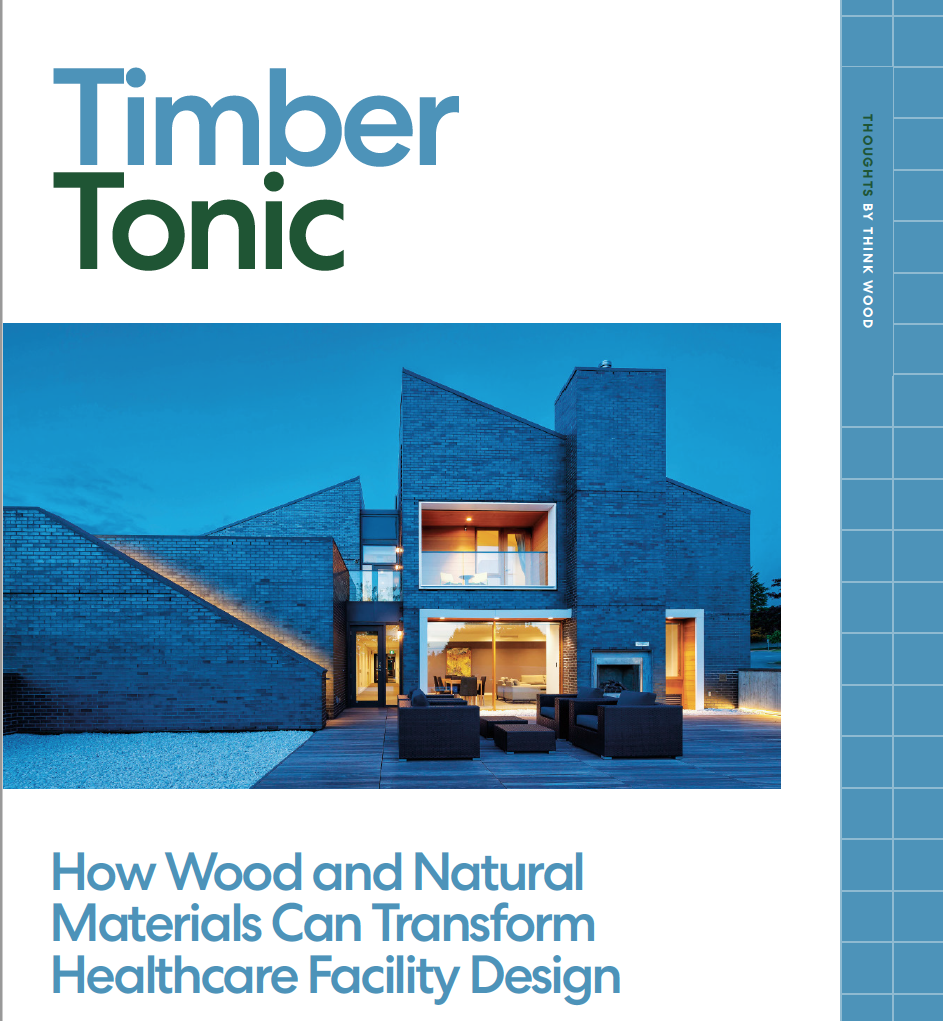
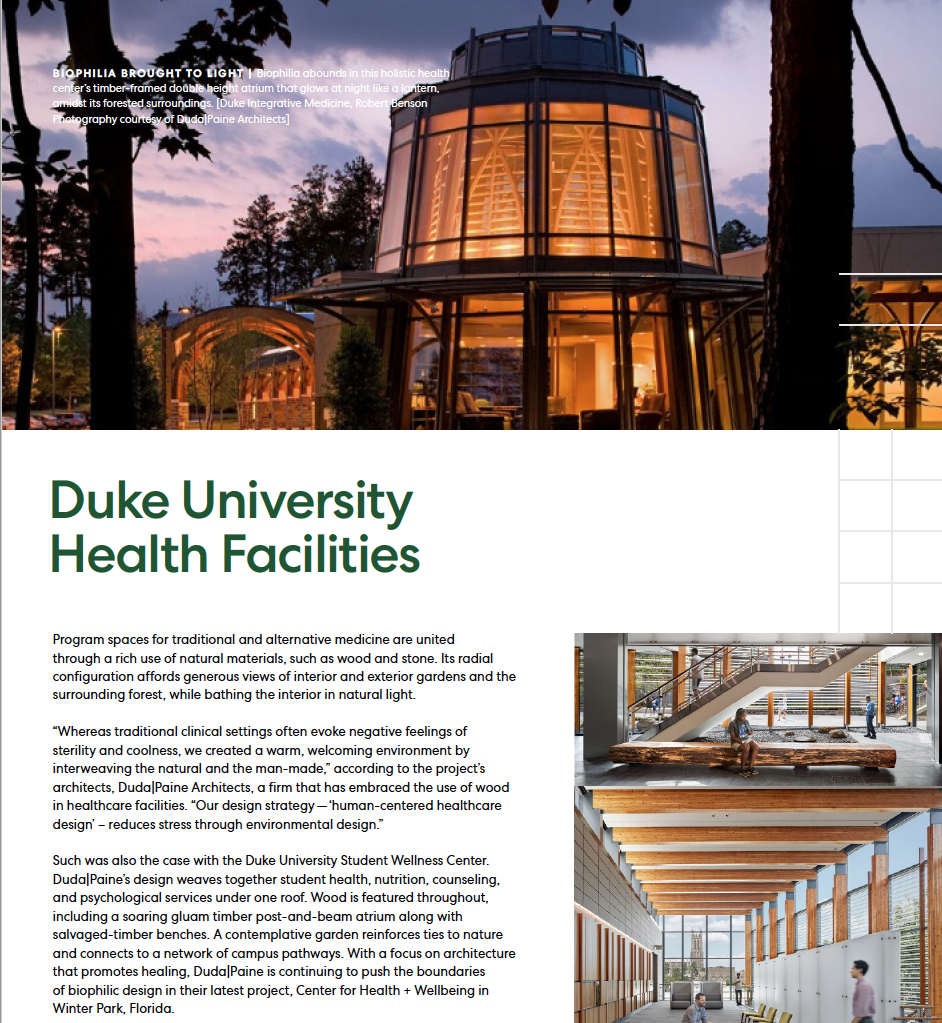
Already growing before the pandemic, the trend of biophilic design continues to gain recognition. People are eager to create connections to nature and natural elements as they spend more time at home and indoors. Forbes, CNBC, and ArchDaily have recently covered the trend and its role in supporting human well-being.
To capitalize on biophilic design’s growth, Think Wood published a series of blogs, web content, and a wellness-focused CEU and will be launching a biophilic design email-nurture series targeting developers and architects next month. Series recipients will receive eight emails covering wood’s role in biophilic design, including case studies and applications of wood use in corporate, retail, medical, and educational settings. The series will culminate with a co-branded lookbook, created in collaboration with WoodWorks, showing inspirational design and construction projects featuring wood as a design element.
FEMA Seismic Provisions Include CLT Shear Wall Requirements

The Federal Emergency Management Agency (FEMA) has released an electronic version of the 2020 seismic design requirements, which for the first time include recommendations on requirements for U.S. seismic design of cross laminated timber (CLT) shear wall systems. The recommendations are based on a CLT shear wall project funded by the USDA Forest Products Laboratory and proposed by a project team that included the AWC.
The CLT shear wall system in the FEMA requirements has been proposed for inclusion in Table 12.2-1 of ASCE 7-22 Minimum Design Loads and Associated Criteria for Buildings and Other Structures. The associated design requirements for CLT shear wall systems are also incorporated in the AWC’s 2021 edition of the Special Design Provisions for Wind and Seismic referenced in the 2021 International Building Code.
Past Investments in Research Pay Off in the Form of New Hotels at Military Bases
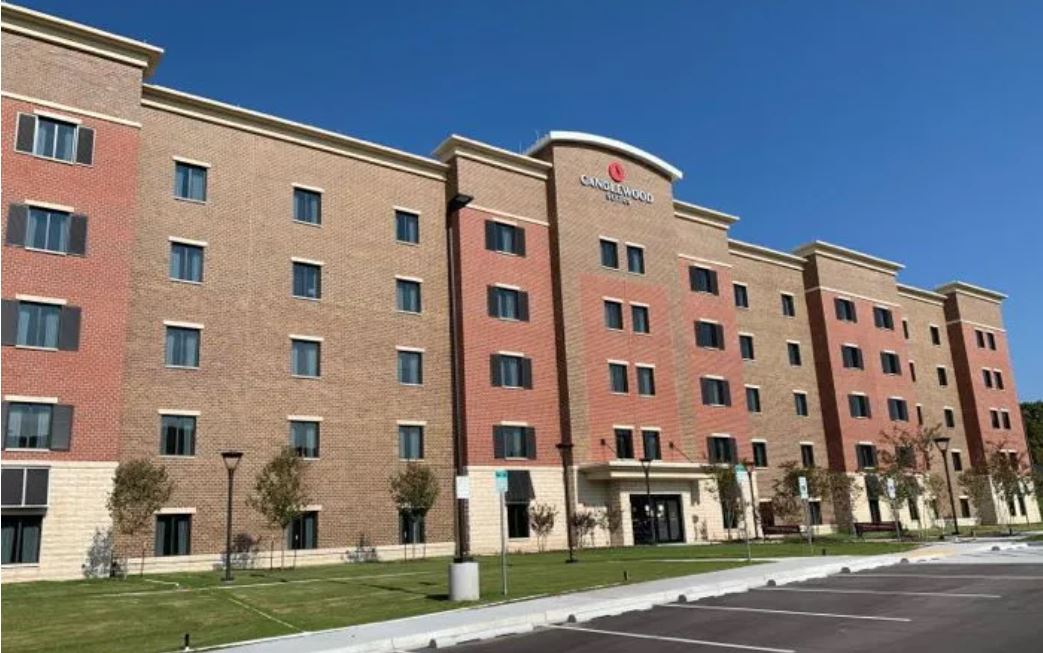
Lendlease and IHG Army Hotels recently completed construction of a 171-room Candlewood Suites hotel made of CLT at Fort Jackson in South Carolina. The new building is their fourth collaboration using CLT on a military base and will soon be followed by a new 146-room facility, also at Fort Jackson. The SLB, USDA Forest Products Laboratory, and WoodWorks were pivotal in unlocking opportunities such as these for mass timber in the U.S. Department of Defense (DOD) construction market; back in 2016 and 2017, the SLB and USDA funded several rounds of live blast and quasi-static testing to generate the data proving mass timber’s performance in blast conditions met DOD regulations.
Read more about Lendlease and IHG’s CLT hotels on military installations here.
Former AWC Manager Receives ICC’s Highest Honor
The prestigious International Code Council (ICC) Bobby J. Fowler Award was presented to Sam W Francis, retired Senior Director of National Programs for the AWC. The award is named for ICC’s first chairperson, who was instrumental in merging the three legacy code organizations into what is now the ICC. It is presented annually to an individual who has dedicated their career to advancing the goals of the ICC with “integrity, professionalism, and compassion,” and it is the highest honor bestowed by the organization. Francis was a code official in Dayton, Ohio, for nearly 20 years before representing the wood industry in the national and international codes arena for 25 years. Besides recognizing his outstanding individual accomplishments, this recognition also reflects the value that the AWC staff brings to the ICC process.
Industry News
Timber Advocate and Former SLB Board Member, Chuck Roady, to Retire After 45 Years
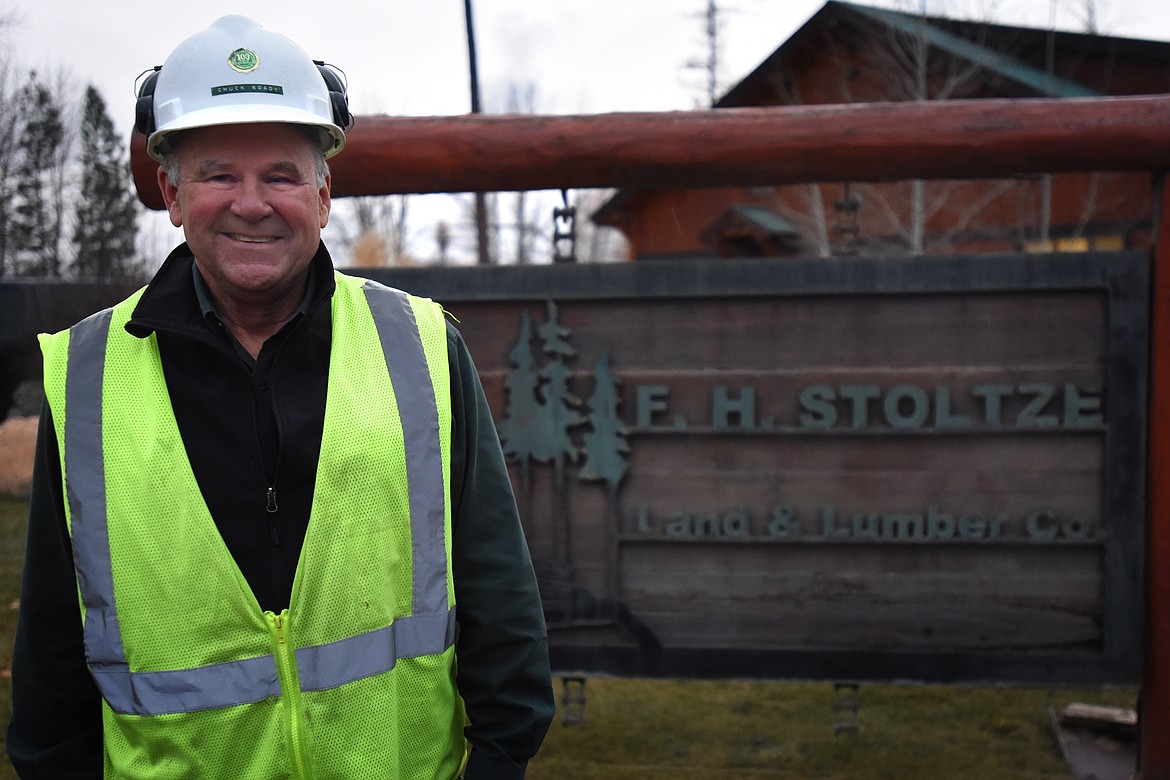
After more than four decades in the Timber industry, Chuck Roady will be retiring from the F.H. Stoltze Land and Lumber Company at the end of December. Armed with a degree in Forestry from the University of Idaho and a desire to protect and develop forests, Roady joined the Pack River Company, starting at the bottom and growing into a leadership role through several acquisitions. Roady joined the F.H. Stoltze Land and Lumber Company as vice president and general manager in 2003. In addition to new responsibilities, Roady continued his tireless advocacy for the proper management of forest lands.
Roady served as a member of several groups over the years, including the SLB Board of Directors and the Federal Forest Resource Coalition.
Thank you for your countless contributions to the forestry industry and congratulations on your well-deserved retirement Chuck Roady. Read more about Roady’s career and legacy here.
CalTech Announces Plans for Research Lab Made of Mass Timber

The California Institute of Technology announced its plans to build an 80,000-square-foot research laboratory made of mass timber at its Pasadena campus. Named the Resnick Sustainability Resource Center, the building is being designed by CannonDesign’s Yazdani Studio and will feature three stories of mass timber and glass with an additional underground level. The school aspires for the building to serve as “a hub for energy and sustainability research,” which made mass timber an obvious choice.
Read more about the project and see a rendering here.
Trend Toward Suburbs, Exburbs Continues
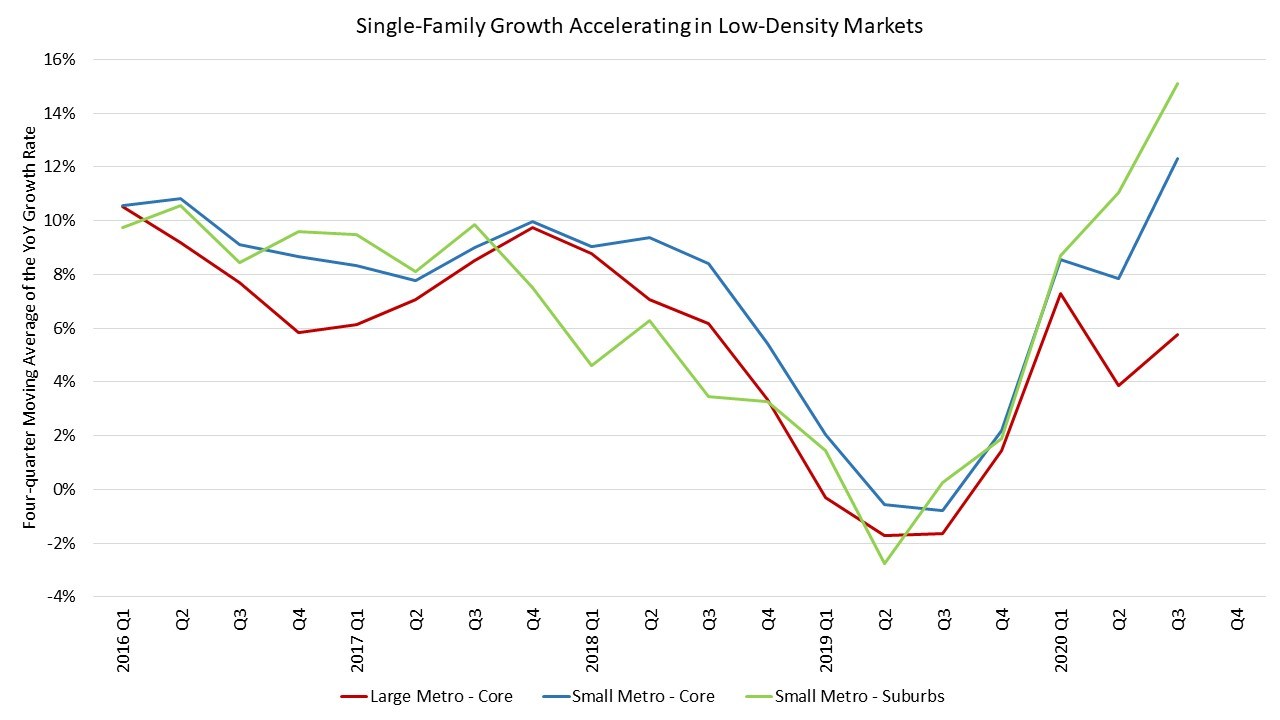
According to the latest data from the National Association of Home Builders’ Home Building Geography Index, consumer demand for housing in suburbs and exurbs continues to grow, including at the expense of urban cores. The trend is fueled by a desire for more space at lower cost, in many cases prompted by the widespread shift to teleworking.
Suburbs of medium-sized cities recorded the largest single-family housing gains in the third quarter, posting a 15% growth rate over the last four quarters. Large metro urban cores performed the worst, posting only a 5.7% gain and a 0.8% drop in market share for single-family construction. The pace of multifamily home building in large metro core areas also declined by 4% over the past year.
Read more about these trends here.
Trends in Modular

Construction Dive’s Modular Monitor series recently reviewed trends affecting modular construction over the past year. Not surprisingly, most trends – whether positive or negative – were unpinned by the coronavirus pandemic. On the plus side, modular’s speed and efficiency advantages were on full display as manufacturers quickly assembled rapid-response medical facilities, and modular’s controlled manufacturing environment helped maintain worker health and safety. On the down side, the segment has not been immune to the overall slumping economic climate, and the construction of several large, permanent modular structures has been put on hold.
Read more here.
Modular and Biophilic Trends Converge in Innovative Design in Amsterdam
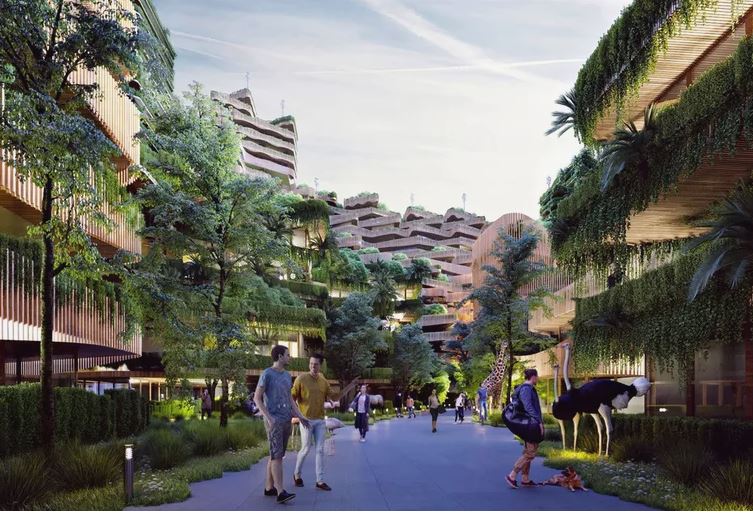
Treehugger recently featured a collaborative effort by GG-Loop and Arup to fuse modular construction, the latest trends in biophilic design, and the idea of regenerative construction in a proposed multifamily housing project in Amsterdam. The project envisions the prominent use of CLT to satisfy its design goals, as CLT’s cost-efficiency and flexibility make it well suited for modular; it supports net-zero or even net-positive construction; and wood invokes nature as few other materials can.
Read more about this innovative project and see renderings here.
Quantifying Mass Timber’s Net Carbon Effect Key to Increasing Market

Mass timber’s potential to help mitigate climate change continues to make headlines worldwide. A recent piece in the Economist notes that while there is general consensus that using mass timber instead of concrete and steel can reduce the construction industry’s greenhouse gas emissions, the net effect of the shift to mass timber requires further investigation and quantification, particularly with regard to forest restoration and land use. As mass timber supply chain development can incentivize and reinforce sustainable forest management and improve carbon sequestration, policies will need to catch up to ensure that mass timber’s potential to mitigate climate change is realized.
10-Story Hybrid Tower Proposed in Portland
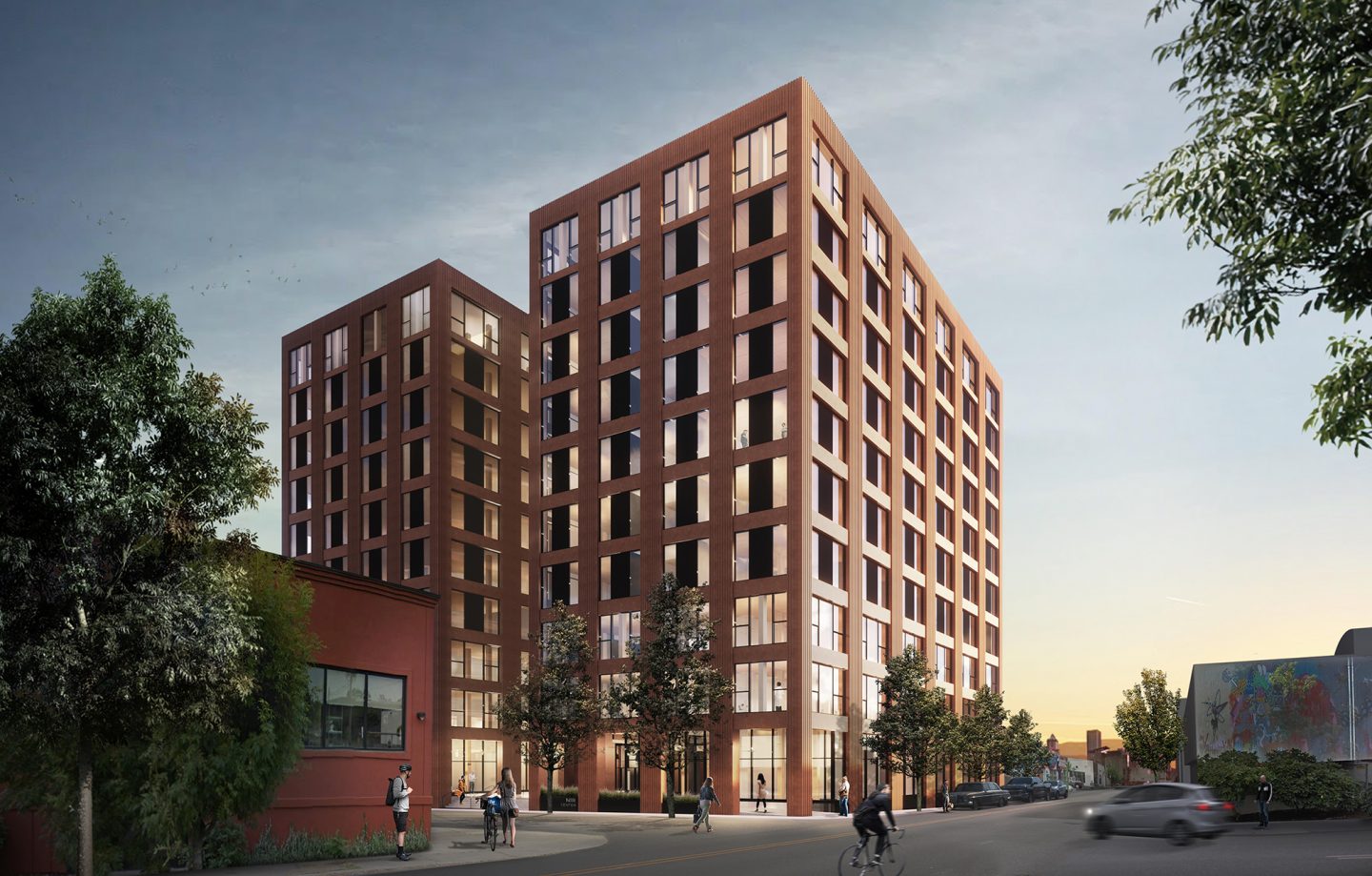
Hennebery Eddy Architects recently profiled Summit Development’s 10-story New Industrial Revolution (NIR) Center in Portland, Oregon, one of the first projects proposed in Portland under the new building code for Type IV-B mass timber construction. By choosing a hybrid solution, the project is set to deliver desired environmental impacts while still trimming construction times and costs. According to life cycle analysis led by the SORA Design Group, the NIR Center will reduce its embodied carbon footprint by 39.3% compared with a business-as-usual building scenario, achieved chiefly by using mass timber and reducing cement content.
Read more about the project here.
Construction Materials Pyramid Offers Fast Environmental Impact Comparison
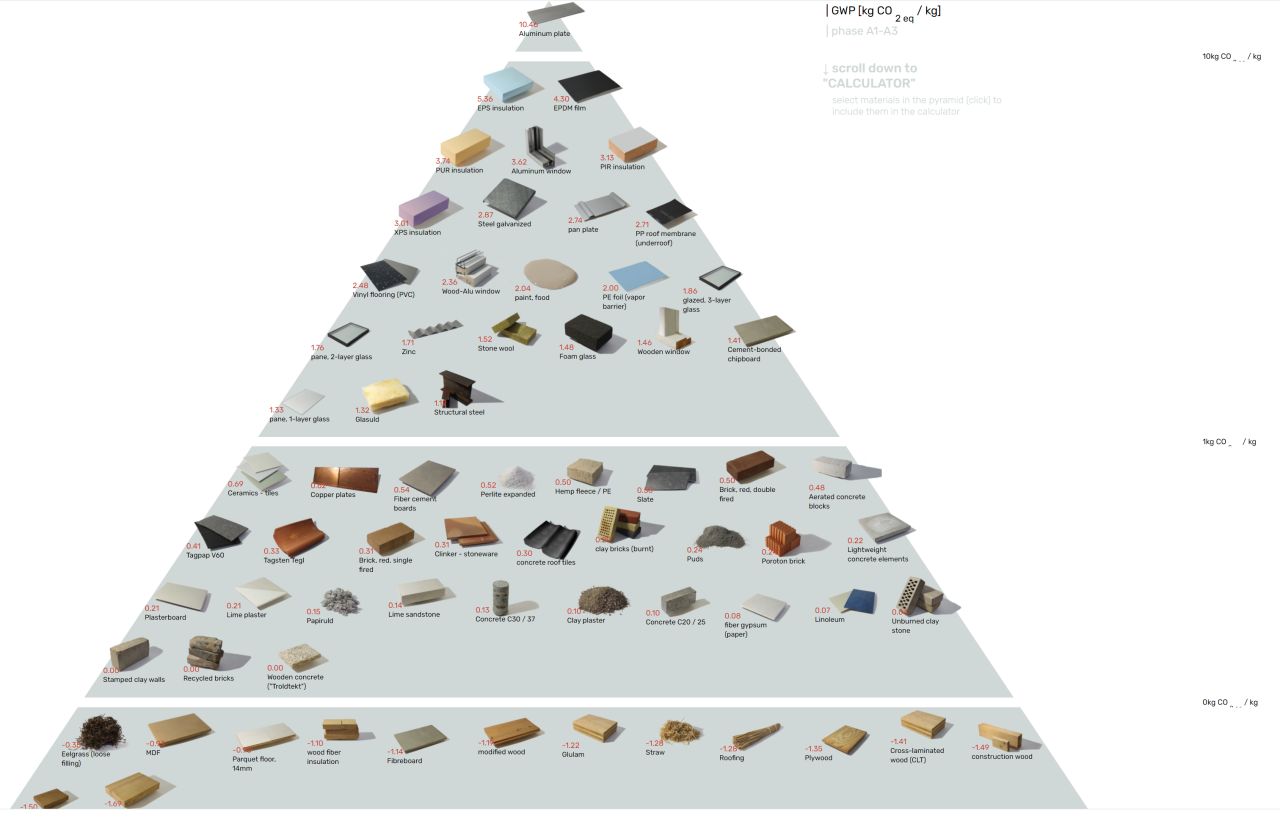
A new “Construction Materials Pyramid” published by Denmark’s Royal Academy of Design, Architecture and Preservation has been making the rounds on the internet and offers a quick and easy way to learn about and compare the potential environmental and carbon impacts of various wood and steel building products.
New Infographic, Data Stress Build-for-Rent as Promising Market Segment
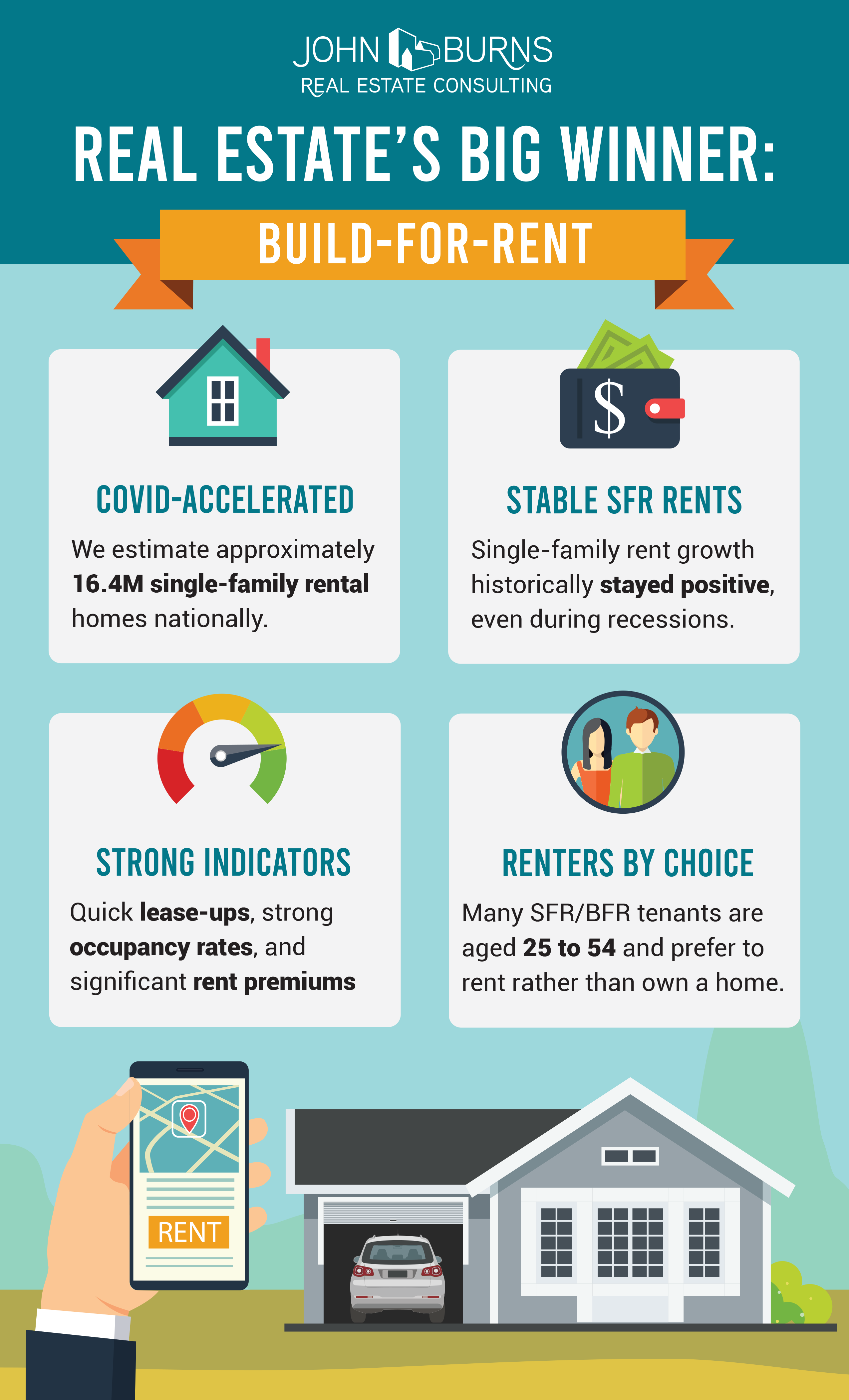
In a new infographic, the housing experts at John Burns Real Estate Consulting tout build-for-rent as the most winning proposition in the housing industry these days. They base their conclusion on growing demand, historic price stability even during economic downturns, high occupancy rates, and the growing consumer preference – especially among 25- to 54-year-olds – to rent instead of owning a single-family home.
In a second piece, John Burns experts offer a glimpse into the data behind their promotion of build-for-rent. The Burns Single-Family Rent Index™ for September 2020, published in November, shows the distribution and rate of growth of the build-for-rent segment nationwide, with 14 urban centers posting 5% or greater gains year-over-year, and a score more posting year-over-year gains of 2% or higher.
University of Oregon Team Working to Increase Wood Use in Medical Facilities
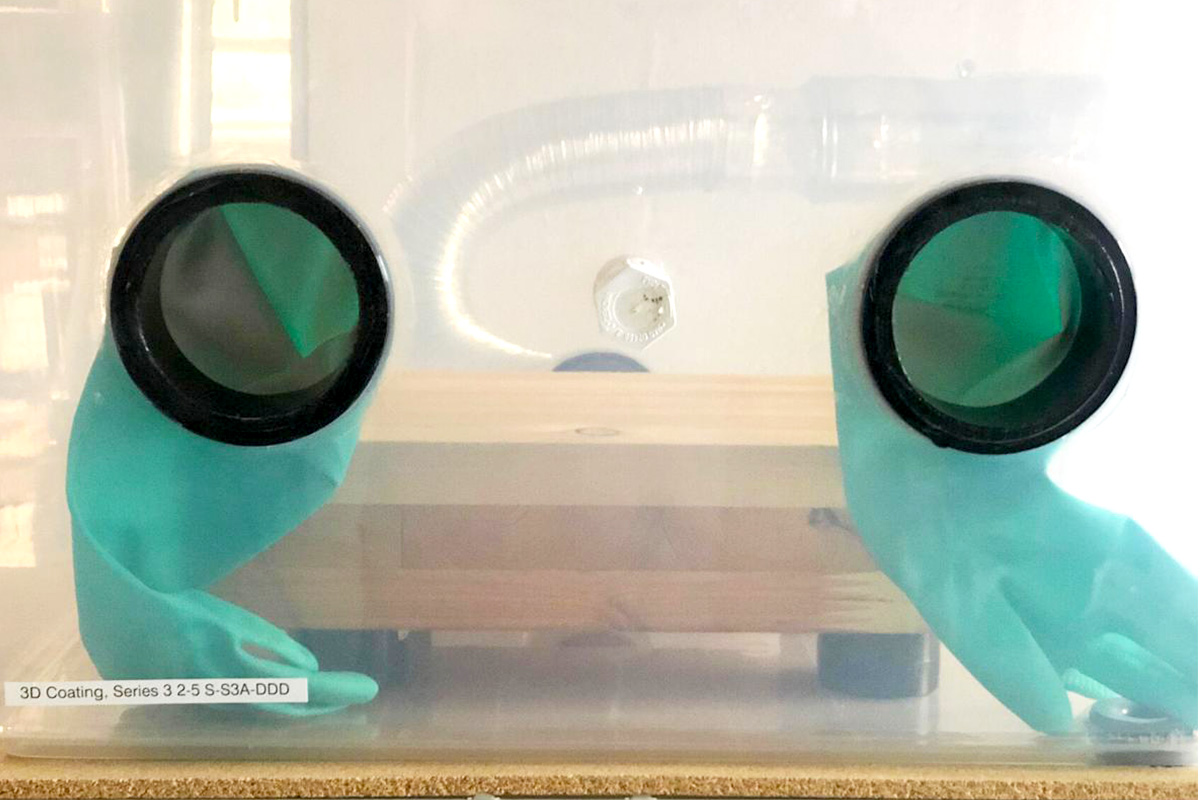
Using funding from a U.S. Forest Service Wood Innovation Grant, a team from the University of Oregon’s Institute for Health in the Built Environment and School of Architecture & Environment is advancing research to demonstrate wood’s performance in healthcare facilities, including in relation to disease control, in the hopes of increasing acceptance of mass timber.
In the study, researchers are monitoring mass timber samples that have been inoculated with pathogens that mimic certain viruses and bacteria in controlled, sterilized environments to determine microbial growth and survival, and how these compare with plastics and other materials commonly found in healthcare settings.
Read more about the study here.
105-Story Mass Timber Skyscraper Could Zero Out Carbon Footprint

Toronto-based architecture firm Dialog, together with engineering and construction partners, has conceptualized a 105-story mass timber skyscraper that has virtually no carbon footprint in situ. By incorporating as much mass timber as possible in the design, the team estimates that the building’s embodied carbon drops by nearly 50% compared with if the building were traditionally built.
Read more about the design and other upcoming tall mass timber buildings here.
Insights on the Competition
New Study Asserts Wood as Key to Reducing Building Sector’s Carbon Footprint

A new study from Aalto University in Finland has found that shifting to wood from other building materials can significantly reduce the environmental impact of building construction. The study estimates that if 80% of new residential construction in Europe was made of wood, including buildings’ structures, cladding, surfaces, and furnishings, they would store 55 million tons of carbon dioxide annually, which is equivalent to approximately 47% of the annual emissions of Europe’s cement industry.
Read more about the study methodology and findings here and here.
Industry Resources
Virginia Tech's Monthly Housing Report
This monthly housing commentary report is a free service of Virginia Tech and is intended to help one gauge future business activity in the U.S. housing market.
October 2020 Reports (released in December 2020)
Part A: October Housing Commentary
Part B: October Economic Conditions


